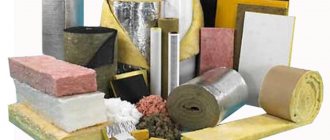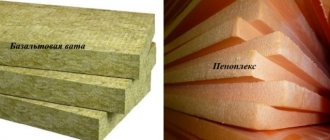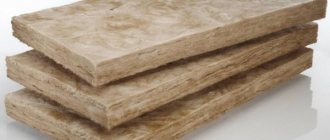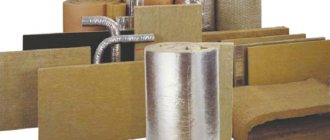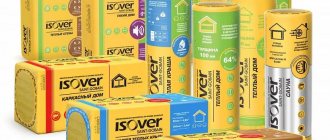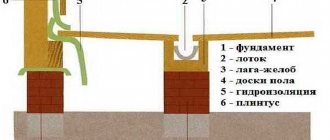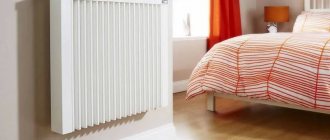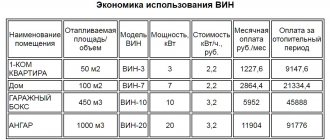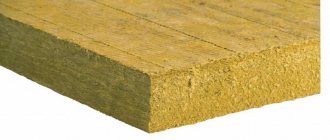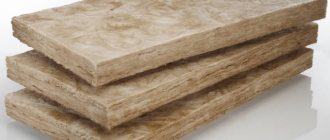Insulation of building structures plays a huge role in maintaining the energy efficiency of a building. The better it is produced, the less expenses are spent on heating, and the longer the life of the house and the more comfortable its microclimate. And the main requirement for thermal insulation is low thermal conductivity, high density, fire safety, good vapor permeability and durability. And this is what fibrous materials like cotton wool can primarily boast of.
Mineral wool is a long-studied and environmentally friendly material with excellent soundproofing properties, low thermal conductivity, biological and chemical resistance, as well as resistance to temperature and mechanical deformation. But everything from this list directly depends on the production technology and the raw materials used.
So let's figure it out, which is better: basalt wool or mineral wool based on slag and glass? Why do you need to wear almost a spacesuit when working with one material, while with another you don’t even need gloves? What is more advisable to purchase to insulate your own home in order to be sure of its durability? We will tell you all about this now.
What is mineral wool and what types does it come in?
Let's start with the fact that mineral wool today is produced both for insulation and for insulating a wide variety of surfaces: from roofs and partitions to high-temperature systems and even water supply lines. It is environmentally friendly, inexpensive and easy to install.
Mineral wool fibers come in a variety of lengths and thicknesses. They are made from minerals, as the name suggests, and, for comparison, there are also fibers made from organic matter. Mineral fibers, depending on the raw material, form glass wool, slag wool and basalt wool, that is, stone wool. Let us also note this important point. In fact, stone wool is mineral wool, because... Yes, it is included in the group of these materials. Therefore, if we compare them all with each other, then in terms of advantages it is basalt wool over glass or slag wool.
The whole secret of how such insulation works is that it traps air and does not allow cold to pass through. Speaking in the language of builders, it has low thermal conductivity. That is why it is customary to install insulation between two spaces that differ in temperature and air humidity. These are walls, floor, ceiling and partitions.
Air is generally the most effective heat insulator. Therefore, high-quality mineral wool is precisely a lush air layer of fibers of different lengths and thicknesses, and in Russia it is produced according to GOST 52953-2008 only from non-combustible materials:
Here is an interesting comparison of both types of material with small experiments (we do not recommend repeating it at home):
Basalt wool
Basalt thermal insulation is made from gabbro-basalt ore. The maximum temperature that basalt insulation can withstand is +1200°C. There are a large number of sizes, densities and shapes of this insulation.
Advantages
Since basalt wool is made from stone, it is non-flammable. Due to this and the high maximum operating temperature, it is used in places where it is necessary to protect the structure from the effects of high temperatures. For example, basalt is excellent for insulating places where a chimney passes through the attic floor.
Basalt insulation does not shrink and also has excellent vapor permeability. Therefore, it is recommended to use it for wooden structures. In addition, basalt thermal insulation does not absorb water from the air and rodents do not eat it.
Flaws
Basalt insulation cannot be considered environmentally friendly, although it is made from natural components. To improve consumer qualities, chemical additives are added to it, which at high temperatures can release harmful volatile substances.
Thermal insulation from gabbro-basalt ore
Rodents are not interested in basalt as food, but they can live in it. As a result, it is necessary to install additional protection against their penetration inside.
Basalt wool does not absorb moisture from the air, but when water hits the surface, it quickly draws it in. Therefore, it cannot be used for insulating foundations, basement floors and blind areas. Also, basalt cannot be considered a good sound insulator, since it only retains airborne noise and allows shock to pass through.
For insulation with low density, wind protection is required, since they are blown. It can also be blown out at the joints, so the slabs must be laid staggered. If it is necessary to lay thermal insulation with a layer of 100 mm, then it is better to do this in 2 layers of 50 mm each.
Basalt insulation does not fit tightly in places where it cannot be positioned at an angle of 90°. Therefore, it is not considered the best option for domes or similar frame structures. When working with basalt wool, you also need to use protective equipment, as it emits dust.
https://youtube.com/watch?v=ivHaQo3exks%3F
Mineral fiber manufacturing technology
As we have already said, depending on the raw materials and the technology used, each insulation will differ in the thickness and orientation of the fibers. In this case, the fibers can be arranged spatially, corrugated, in horizontal or vertical layers, depending on what equipment they were melted on.
But the general principle is this:
As a result of production, mineral wool of different colors, thicknesses and fiber lengths is obtained, which directly affects its properties. On the Russian market, all three types have this cross-sectional view:
The prickly, ubiquitous glass wool
Cylindrical glass wool is now actively used for thermal insulation of pipelines, and in the form of slabs - for ventilated facades. This material is even used in aviation! They are used to decorate cabins to achieve the necessary protection against heat loss and muffle sounds. Glass wool also always insulates components that get too hot.
Glass wool is good because it can withstand vibration loads well. It is made from dolomite, sand, limestone or cullet. Usually it is yellow, very light or more saturated (abroad - more often pink).
The process itself is simple: broken glass or its equivalent is heated to almost one and a half thousand degrees until the glass begins to melt. Then thin fibers with a thickness of 5 to 15 microns and a length of 15 to 50 mm are easily drawn from them. The threads dry out and curl into cotton wool:
The material is quite strong and elastic, but it is not easy to work with. The fact is that all these glass fibers are quite fragile, and when they break, they fall on the skin and eyes in the form of thousands of small sharp needles, causing redness and irritation.
And if you inhale glass dust, it will be bad for your lungs. That is why they work with such material only in a protective suit and a respirator, although there are many extreme sports enthusiasts.
Reliable and fireproof stone wool
Stone wool is made by alloying rocks and a mixture of metallurgical slags. The raw materials used are basalt, diabase, or gabbro with the addition of limestone or dolomite rocks. Vapor permeability – within 0.25-0.35 mg/m²*h*pa. Such thermal insulation costs significantly more than glass wool, but it also has completely different characteristics. But in terms of heat and sound insulation, both materials are similar.
By the way, for some roofing structures only basalt wool, which is quite tensile strength, is suitable. Neither glass wool nor slag wool can boast of this quality.
Available and soft slag wool
Another common mineral wool insulation is slag wool, produced from waste from the metallurgical industry. Such raw materials are obtained during the melting process in coke cupola furnaces. The so-called cupola method, which improves the physical and mechanical properties of wool and reduces the cost of the process.
The only negative is that during the production of blast furnace slag the acidity indicator remains unstable. After all, the blast furnace slag itself for slag wool is obtained in the process of smelting cast iron. Because of this, mineral wool in different packages may differ slightly in its properties and reactions to environmental influences.
Those. It may turn out that your neighbor’s attic, insulated with the same brand of slabs, can last longer than yours. In a word, it is difficult to predict the end result here. And the threads themselves are obtained from molten blast furnace slag, with a thickness of 4 to 12 microns and a length of 16 mm. The result is quite elastic and heat-insulating wool. Its thermal conductivity coefficient is 0.46 - 0.48 W/(m∙k).
Also, residual acidity in a damp room can negatively affect metal surfaces. Slag wool absorbs moisture quite quickly, and therefore cannot be used for insulation in the bathroom. Because of these features, plastic and metal pipes are never insulated with it. But it is not suitable for finishing the facade at all.
But slag wool does not prick like glass wool, although its dust often floats in the air and creates an unpleasant sensation when inhaled. Also, unfortunately, slag wool contains formaldehyde resin, which releases phenol.
This is unsafe for human health, so during the installation process you must especially carefully observe safety precautions. It is important to cover such insulation with a vapor barrier film without gaps. Although this also applies to the previous two types.
Comparison of technical characteristics: which raw materials are better?
Any insulation is always subject to such important requirements as heat retention and durability. In this, mineral wool has a significant advantage over other types of thermal insulation materials (despite the fact that glass wool has a service life of only 7 years).
At the same time, all manufacturers are actively working to improve their products, constantly conduct research in their laboratories and make sure that their products are convenient and safe for insulating ordinary residential buildings. This can't help but rejoice!
As for raw materials, we can say that there are no bad insulation materials, it’s just that each option is better suited for a specific construction task. That is why it is so important to know the technical characteristics of all three types of mineral wool and their differences from each other.
Thermal conductivity and elasticity
So, let's start with thermal conductivity, i.e. ability to retain heat by the material itself. For glass wool and basalt slabs it is at the same level. This is respectively 0.041 W/m*k and 0.038 W/m*k.
For your own interest, you can search for popular videos on Youtube, where craftsmen are actively testing different types of mineral wool. For example, sticking thermometers into pieces of insulation right on the street, and observing which of the insulation does its job better. The difference turns out to be literally 1-2 degrees, which cannot be called significant.
Next are density and elasticity, which affect the installation process and the weight of the structure. For some roofs, thermal insulation also performs load-bearing functions, for example, in the case of inversion roofs. Therefore, strength characteristics are more important here.
For example, fiberglass has a low density. This type of wool has a compressive strength of 40-45 kPa with a density of about 115 kg per m3. Due to this, the weight of glass wool is significantly lower than basalt.
By the way, the ability to compress and recover without deformation is clearly visible to the naked eye when the packages with insulation are opened:
The density of mineral wool also directly affects its final strength. The better the density, the stronger the insulation. These are important technical parameters that determine for what load one or another type of mineral wool can be taken.
Fire safety and fire resistance
As for fire safety, both mineral and basalt wool do not burn in a fire. At most, their fibers can be baked with each other at a certain temperature. For example, glass wool melts already at 300 degrees Celsius, slag fibers do not lose their properties even when heated to 700 degrees Celsius, and basalt wool can withstand even at 1000 degrees.
But keep in mind that if you choose stone wool based only on such considerations, this is not entirely true. The fact is that wool may not catch fire at a temperature of 1000 degrees Celsius, but waterproofing films and attic cladding definitely do.
The advantage of all types of mineral wool is that they themselves do not support open fire. If you compare them with foam and polystyrene products, then this is a valuable point.
The fact is that during the process of fire spread, polystyrene foam or expanded polystyrene not only burn actively, but also help the fire spread quickly and efficiently. They say about such houses that they “blazed up like a match”:
Cotton wool and skin irritation
Another important point regarding mineral wool. One of its main disadvantages is the harmful dust and causticity of the material itself. But not everyone knows that this is a typical sign of the presence of short and thin fibers in the insulation.
For pebbled boards, the fiber thickness is usually 0.02 mm and the length is less than 3 mm. Those. The thinner and shorter the fibers, the more they look like small needles. Even cutting such a slab is not very pleasant: it is reminiscent of touching dried bread, a lot of effort and a lot of crumbs everywhere. But the longer the fibers, the easier it is to work with them: they are easy to cut, generate almost no dust and do not irritate the skin of the hands.
Basalt wool has an order of magnitude fewer problems with this, and most modern products in this series do not require the use of special protective equipment at all, except for gloves. Although, in fact, glass wool is not such a bad material if you follow the installation instructions and take care of your own safety.
Unfortunately, even with all the awareness, many home craftsmen still have a certain recklessness, due to which they calmly take glass wool with their bare hands and do not care too much about tightly insulating it from the living room. And then these same people write negative reviews on manufacturers’ websites stating that their cotton wool is environmentally unsafe and generally unbearable for the human body.
Important environmental issues
Let's consider this important point. Almost all stone wool manufacturers produce an environmentally friendly product, without toxic substances, which does not emit any unpleasant odors into the room. This type of insulation is truly safe for human health. In addition, such factories even use waste-free production, which is also important for the environment.
As for the environmental safety of other types of mineral wool, such as glass or slag wool, there are several points in contrast to stone wool. Mineral wool may contain small amounts of phenol-formaldehyde resin. But in fact, even during the production process at high temperatures, it polymerizes and turns into an inactive solid state. It no longer remains in its free form, and it does not in any way affect people living in an insulated house. Although formaldehyde is still used to make glass wool.
In fact, stone wool, especially older ones, sometimes contains this substance. The whole problem is in the layered structure of cotton wool: the fibers are arranged chaotically, resulting in the formation of a large number of air pores. And derivatives of phenol-formaldehyde resin, as a binder, transform individual fibers into a strong and elastic fabric that does not crumble or sag. Those. this is a truly important component for production.
And cotton wool with this composition is more durable and stable. Therefore, some manufacturers still contain formaldehyde resin in stone wool, although much less - only from 2.5 to 10%. But the less formaldehyde, the less moisture-resistant the insulation itself, although this is precisely how the threat of benzene evaporation is reduced.
Of course, all these additives are usually contained within normal limits, which is relatively safe for humans and the environment. Today, special laboratories test mineral wool insulation for all these parameters. Moreover, the tests take place in several stages - this is a radiation assessment, a washout for general toxicity and an assessment of the release of harmful substances into the atmosphere.
To assess the level of organic substances in mineral wool, it is placed in a climate chamber for a day and kept at the desired temperature and air humidity for some time. This is how they check whether mineral wool meets the sanitary and hygienic requirements recognized in Russia.
That's why, if you're concerned about the environmental friendliness of a material, ask for a quality certificate. After all, today there is a rather tough struggle in the construction market and sometimes myths are spread about the unsafety of this or that insulation.
Durability and resistance to shrinkage
Another significant disadvantage of glass wool is its ability to shrink. It is because of this that it has a short lifespan, while stone wool is much more durable and retains its shape well for many years.
And if we talk about price, then, of course, glass wool is the most affordable. With all its shortcomings, it is great for rooms that first need sound insulation, and only then everything else.
PROPERTIES OF MINERAL WOOL
We’ve sorted out the properties of glass wool, now let’s look at the features of mineral wool. It’s not for nothing that it is used so often in construction.
Mineral wool is probably the most popular construction insulation of recent decades. However, it has been used for so long that it is difficult to remember.
Previously, mineral wool had many advantages and disadvantages. The disadvantages included weak density, the ability to undergo slight shrinkage, the inability to withstand direct loads, etc.
She also did not experience contact with water in the best way. Plates or rolls, just like fiberglass, absorbed moisture, accumulating it inside. But here the moisture had a different effect.
Installation of mineral wool is done with your own hands and without special tools
Because of it, the insulation became cold and damp, and then completely began to rot or mold. Fortunately, almost all of these shortcomings have been eliminated through the invention of new production technologies.
ADVANTAGES AND DISADVANTAGES
Modern basalt wool is an extremely reliable thermal insulation material. In terms of thermal conductivity, it is even better than fiberglass. Basalt wool also weighs less than its glass wool counterpart, but here the difference is not so significant.
Moreover, modern manufacturers produce various samples of basalt wool. There are both heavy slabs for thermal insulation of flat roofs or walls, and light, airy slabs that can be easily mounted into slopes and weigh almost nothing.
Therefore, you can easily choose the option that will be better suited for a given situation. Moreover, the variety of insulation on the market is so significant that you may even get confused when purchasing.
Modern samples of basalt wool are not afraid of water. Their absorption coefficient is 1-2%, which is a very good indicator. In fact, a part of the insulation lowered into water will not absorb a drop of liquid. It will simply drain from the material as soon as you remove it from the water.
Basalt mineral wool also does not burn in fire. This is already its unique feature. Moreover, studies by builders have shown that basalt wool can be burned with a gas burner without fear. And it will burn only in the place of direct contact with fire.
No damage from exposure to high temperatures is observed at all. You can place your hands on the second side of the stove and not feel the temperature rise at all.
We also note that basalt insulation is not eaten by rodents or insects. It's also much easier to work with. Roughly speaking, cotton wool is completely safe for humans, and you can install it yourself.
As for the minuses, the only thing we can note here is the high price. Indeed, the price of basalt wool is at a very decent level. In fact, it is considered the highest of all competitors.
Installation process for fiberglass insulation
The second point is the undesirable use of mineral wool slabs for insulation of baths, bathrooms, etc. Of course, the water absorption of modern wool is at a very low level, but with wet steam things are different.
It’s better not to take risks here, since in the aggressive conditions of the bath, cotton wool will still be prone to gradual accumulation of liquid.
Let us now bring together all these pros and cons, forming a complete list of parameters.
Main advantages:
- Convenience and ease of installation;
- Light weight;
- Environmentally friendly, safe for health;
- Does not absorb water;
- Vapor permeable;
- Has high density;
- Does not burn in fire;
- Excellent thermal conductivity.
Main disadvantages:
- High price;
- It is not advisable to use it to insulate baths.
SO WHAT IS THE BEST BUY?
As you can see, glass wool differs from basalt wool, although their standard indicators are almost the same.
But if we start a close comparison, then mineral wool is still better in thermal conductivity and density
It does not shrink, does not absorb water as much and, most importantly, is absolutely safe for humans
On the side of glass wool is its low price and optimal properties.
If we talk about specific solutions, we recommend using basalt wool. It is better than fiberglass insulation in almost every way. And the price, although higher, is completely worth the money spent.
If you don’t have enough money, then you can turn to glass wool, but here you have to be careful.
Subtleties of installation and operation: some pitfalls
Both glass wool and basalt slabs are suitable for insulating building structures of a house. Both types of materials are supplied to the market in a format convenient for installation - slabs, rolls and mats with similar technical characteristics, which we discussed above:
All types of mineral wool are easy to install. They are slightly springy, they are quite easy to cut and insert between the rafters a little under tension. So that they are supported by their own weight and elasticity. The only thing is that glass wool and slag wool have less weight, and therefore create less load.
Slabs with a thermal conductivity of 0.037 W/m*k are suitable for insulating pitched roofs. Glass wool with such parameters will already have a low density, due to this it has less weight and elasticity, which will guarantee its tight fit to the structure itself:
Basalt wool is a little heavier and denser, but it is easier to cut, looks more neat and holds more securely without shrinking over time:
Also, stone wool is used to insulate floors:
To sum it up: the choice is yours. Both basalt and other mineral wool have a number of advantages and minor disadvantages. Therefore, be guided by their main technical characteristics, as well as your own expectations and requirements for thermal insulation.
